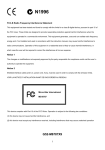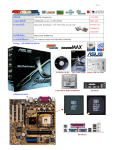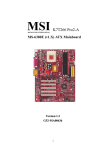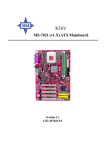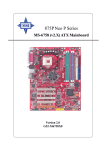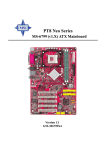Download MSI MS-6787 Instruction manual
Transcript
P4MAM Series MS-6787 (v1.X) M-ATX Mainboard Version 1.1 G52-M6787X3 i Manual Rev: 1.1 Release Date: July 2003 FCC-B Radio Frequency Interference Statement This equipment has been tested and found to comply with the limits for a class B digital device, pursuant to part 15 of the FCC rules. These limits are designed to provide reasonable protection against harmful interference when the equipment is operated in a commercial environment. This equipment generates, uses and can radiate radio frequency energy and, if not installed and used in accordance with the instruction manual, may cause harmful interference to radio communications. Operation of this equipment in a residential area is likely to cause harmful interference, in which case the user will be required to correct the interference at his own expense. Notice 1 The changes or modifications not expressly approved by the party responsible for compliance could void the user’s authority to operate the equipment. Notice 2 Shielded interface cables and A.C. power cord, if any, must be used in order to comply with the emission limits. VOIR LA NOTICE D’INSTALLATION AVANT DE RACCORDER AU RESEAU. Micro-Star International MS-6787 Tested to comply with FCC Standard For Home or Office Use ii Copyright Notice The material in this document is the intellectual property of MICRO-STAR INTERNATIONAL. We take every care in the preparation of this document, but no guarantee is given as to the correctness of its contents. Our products are under continual improvement and we reserve the right to make changes without notice. Trademarks All trademarks are the properties of their respective owners. Intel® and Pentium® are registered trademarks of Intel Corporation. PS/2 and OS®/2 are registered trademarks of International Business Machines Corporation. Windows ® 95/98/2000/NT/XP are registered trademarks of Microsoft Corporation. Netware® is a registered trademark of Novell, Inc. Award® is a registered trademark of Phoenix Technologies Ltd. AMI® is a registered trademark of American Megatrends Inc. Revision History Revision V1.1 Revision History Remove JKBV1 jumper Date July 2003 Technical Support If a problem arises with your system and no solution can be obtained from the user’s manual, please contact your place of purchase or local distributor. Alternatively, please try the following help resources for further guidance. Visit the MSI website for FAQ, technical guide, BIOS updates, driver updates, and other information: http://www.msi.com.tw/ Contact our technical staff at: [email protected] iii Safety Instructions 1. 2. 3. 4. 5. Always read the safety instructions carefully. Keep this User’s Manual for future reference. Keep this equipment away from humidity. Lay this equipment on a reliable flat surface before setting it up. The openings on the enclosure are for air convection hence protects the equipment from overheating. DO NOT COVER THE OPENINGS. 6. Make sure the voltage of the power source and adjust properly 110/220V before connecting the equipment to the power inlet. 7. Place the power cord such a way that people can not step on it. Do not place anything over the power cord. 8. Always Unplug the Power Cord before inserting any add-on card or module. 9. All cautions and warnings on the equipment should be noted. 10. Never pour any liquid into the opening that could damage or cause electrical shock. 11. If any of the following situations arises, get the equipment checked by a service personnel: z The power cord or plug is damaged. z Liquid has penetrated into the equipment. z The equipment has been exposed to moisture. z The equipment has not work well or you can not get it work according to User’s Manual. z The equipment has dropped and damaged. z The equipment has obvious sign of breakage. 12. DO NOT LEAVE THIS EQUIPMENT IN AN ENVIRONMENT UNCONDITIONED, STORAGE TEMPERATURE ABOVE 600 C (1400F), IT MAY DAMAGE THE EQUIPMENT. CAUTION: Danger of explosion if battery is incorrectly replaced. Replace only with the same or equivalent type recommended by the manufacturer. iv CONTENTS FCC-B Radio Frequency Interference Statement .......................................... iii Copyright Notice .......................................................................................... iii Revision History ........................................................................................... iii Technical Support ......................................................................................... iii Safety Instructions ....................................................................................... iv Chapter 1. Getting Started ........................................................................ 1-1 Mainboard Specifications .................................................................... 1-2 Mainboard Layout ............................................................................... 1-4 MSI Special Features ........................................................................... 1-5 Color Management ........................................................................ 1-5 PC Alert™ 4 ................................................................................... 1-6 Fuzzy Logic™ 4 ............................................................................. 1-7 Live BIOS™/Live Driver™ ............................................................ 1-9 Live Monitor™ .............................................................................. 1-9 Chapter 2. Hardware Setup ....................................................................... 2-1 Quick Components Guide .................................................................... 2-2 Central Processing Unit: CPU .............................................................. 2-3 CPU Core Speed Derivation Procedure ......................................... 2-3 CPU Installation Procedures for Socket 478 .................................. 2-4 Installing the CPU Fan .................................................................. 2-5 Memory ................................................................................................ 2-7 Memory Speed/CPU FSB Support Matrix ..................................... 2-7 DDR Module Combination ............................................................ 2-7 Installing DDR Modules ............................................................... 2-8 Power Supply ....................................................................................... 2-9 ATX 20-Pin Power Connector: ATX1 ............................................ 2-9 ATX 12V Power Connector: JPW1 ................................................ 2-9 Back Panel .......................................................................................... 2-10 v Connectors ......................................................................................... 2-11 Floppy Disk Drive Connector: FDD1 ........................................... 2-11 Fan Power Connectors: CFAN1/SFAN1 ...................................... 2-11 Hard Disk Connectors: IDE1, IDE2 .............................................. 2-12 IrDA Infrared Module Header: JIR1 (Optional) ........................... 2-13 Chassis Intrusion Switch Connector: JCI1 (Optional) ................. 2-13 CD-In Connector: CD_IN1 .......................................................... 2-14 SPDIF-Out Connector: JSPDIF1 (Optional) ................................. 2-14 Front Panel Connectors: JFP1/JFP2 ............................................. 2-15 Front Panel Audio Connector: JAUDIO1 .................................... 2-16 Front USB Connector: JUSB1 ...................................................... 2-17 Jumpers .............................................................................................. 2-18 Clear CMOS Jumper: JBAT1 ........................................................ 2-18 CPU Support Jumper: JP1 ............................................................ 2-19 Slots ................................................................................................... 2-20 AGP (Accelerated Graphics Port) Slot ......................................... 2-20 PCI (Peripheral Component Interconnect) Slots .......................... 2-20 CNR (Communication Network Riser) Slot .................................. 2-20 PCI Interrupt Request Routing .................................................... 2-21 vi Getting Started Chapter 1. Getting Started Getting Started Thank you for choosing the P4MAM Series (MS-6787 v1. X) micro ATX mainboard. The P4MAM Series is based on VIA® VT8751A & VT8235 chipsets for optimal system efficiency. Designed to fit the advanced Intel® Pentium® 4 processors in 478 pin package, the P4MAM Series delivers a high performance and professional desktop platform solution. 1-1 MS-6787 M-ATX Mainboard Mainboard Specifications CPU h Supports Intel® Pentium® 4/Celeron (Socket 478) processor. h FSB @ 400MHz/533MHz. h Supports up to 3.06GHz. Chipset h VIA® VT8751A chipset (664 BGA) - 64bit P4 processors FSB I/F (533MHz). - 64bit DDR SDRAM memory I/F (200/266MHz). - 32bit AGP I/F (66MHz) for 4x/2x mode. - 8bit V-Link I/F (66MHz) with peak bandwidth of 266MB/s. h VIA® VT8235 chipset (376 BGA) - Dual-channel UDMA 133/100/66/33 master mode EIDE controller. - 6 ports USB controller (v2.0). - KBD controller with PS2 mouse support. - SMBus I/F and ACPI/APM compliance power management. - LPC I/F for super I/O and 2MB flash ROM (BIOS). - AC-97 link controller to cooperate w/ external AC97 audio & modem codec. - 10/100Mbps Fast Ethernet controller. - Supports HSP modem. Main Memory h Supports four memory banks using two 184-pin DDR DIMM. h Supports up to 2GB PC2100/PC1600 SDRAMs. h Supports 2.5v DDR SDRAM. Slots h One AGP (Accelerated Graphics Port) 4x slot. h Three PCI 2.2 32-bit PCI bus slots (support 3.3v/5v PCI bus interface). h One CNR (Communication Network Riser) slot. On-BoardIDE h An IDE controller on the VIA® VT8235 Chipset provides IDE HDD/CDROM with PIO, Bus Master and Ultra DMA 33/66/100/133 operation modes. h Can connect up to four IDE devices. 1-2 Getting Started On-Board Peripherals h On-Board Peripherals include: - 1 floppy port supports 2 FDDs with 360K, 720K, 1.2M, 1.44M and 2.88Mbytes - 1 serial port (COM A) - 1 parallel port supports SPP/EPP/ECP mode - 6 USB 2.0 ports (Rear * 4/ Front * 2) - 1 audio (Line-In/Line-Out/Mic) port - 1 RJ45 LAN jack - 1 VGA port Audio h AC97 link controller integrated in VT8235. h VIA® VT1616 6-channel software audio codec. - Compliance with AC’97 v2.2 spec. LAN h VIA® VT6103 PCI local bus single-chip Fast Ethernet Controller. - With external 10/100 Base-T Lan transformer. - Integrated Fast Ethernet MAC and PHY in one chip. - Supports 10Mb/s and 100Mb/s auto-negotiation operation. - Compliance with PCI v2.2 and PC99 standard. - Supports ACPI power management. BIOS h The mainboard BIOS provides “Plug & Play” BIOS which detects the peripheral devices and expansion cards of the board automatically. h The mainboard provides a Desktop Management Interface (DMI) function which records your mainboard specifications. Dimension h Micro-ATX Form Factor: 243mm x 214mm. Mounting h 6 standard mounting holes. 1-3 MS-6787 M-ATX Mainboard Mainboard Layout FDD 1 Top: Mouse Bottom: Keyboard CFAN1 USB Ports ATX1 JPW1 Top: Parallel Port Bottom: COM A VGA Port VIA VT8751A Top: LAN Jack Bottom: USB Ports IDE 1 (Optional) AGP Slot BIOS PCI Slot 1 JSPDIF1 JIR1 (Optional) IDE 2 JCI1 DIMM 1 VIA VT6103 Winbond W83697HF DIMM 2 T: Line-In M: Line-Out B: Mic PCI Slot 2 CD_IN1 VIA VT8235 PCI Slot 3 Codec BATT + JAUDIO1 CNR SFAN1 JP1 JFP1 JFP2 JUSB1 JBAT1 P4MAM Series (MS-6787 v1.X) Micro ATX Mainboard 1-4 Getting Started MSI Special Features Color Management MSI has an unified color management rule for some connectors on the mainboards, which helps you to install the memory modules, expansion cards and other peripherals devices more easily and conveniently. h Intel spec IDE ATA66/100/133 connector: 1st IDE in blue, 2nd IDE in white h AGP slot: red h USB 2.0 connector: yellow h Front panel connector JFP1: HDD LED in red, Reset Switch in blue, Power Switch in black, Power LED in light green. h Front panel connector JFP2: Power LED in light green. Intel Spec IDE ATA66/100/133 Connectors: 1st IDE: Blue/2nd IDE: White AGP Slot Front Panel Connector JFP2 USB 2.0 Connector Front Panel Connector JFP1 1-5 MS-6787 M-ATX Mainboard PC Alert™ 4 The PC AlertTM 4 is a utility you can find in the CD-ROM disk. The utility is just like your PC doctor that can detect the following PC hardware status during real time operation: Ø monitor CPU & system temperatures Ø monitor fan speeds Ø monitor system voltages If one of the items above is abnormal, the program main screen will be immediately shown on the screen, with the abnormal item highlighted in red. This will continue to be shown until the condition returns to the normal status. Adjusting Keys Temperature Modes Users can use the Adjusting Keys to change the minimum and maximum threshold of each item for the system to send out a warning message. Click Temperature to select the temperature modes of either Fahrenheit (oF) or Celsius (oC). The PC Alert™ 4 icon on the Status Area will show the current CPU temperature. MSI Reminds You... 1. Items shown on PC Alert 4 vary depending on your system status. 2. Whenever the minimum or maximum threshold of each item has been changed, please close the PC Alert 4 program for the new settings to take effect. 1-6 Getting Started Fuzzy Logic™ 4 The Fuzzy Logic™ 4 utility is a user friendly tool that allows users to view and adjust the current system status. To overclock the CPU FSB (Front Side Bus) frequency under the Windows operating system, click FSB and use the right and left arrow keys to select the desired FSB, and then click Apply to apply the new setup value. To enable the system running at the specified FSB every time when you click Turbo, click Save to save the desired FSB first. If you want to know the maximal CPU overclocking value, click Auto to start testing. The CPU FSB will automatically increase the testing value until the PC reboots. After rebooting, click Turbo to apply the test result. Click Default to restore the default values. Features: Ø MSI Logo Ø CPU Speed Ø Ø Ø Ø Ø Voltage MSI Info CPU Info CPU Fan Speed CPU Temp. links to the MSI Web site allows users to adjust the CPU speed through CPU Multiplier and FSB allows user to adjust the voltage of CPU/Memory/AGP provides information about the mainboard, BIOS and OS provides detailed information about the CPU shows the current running speed of CPU Fan shows the current CPU temperature MSI Reminds You... To adjust the options under CPU Speed and Voltage, use the right and left arrow keys to select the desired value and then click Apply to run the setup value. 1-7 MS-6787 M-ATX Mainboard Live BIOS™/Live Driver™ The Live BIOS™/Live Driver™ is a tool used to detect and update your BIOS/drivers online so that you don’t need to search for the correct BIOS/driver version throughout the Web site. To use the function, you need to install the “MSI Live Update 2” application. After installation, the “MSI Live Update 2” icon (as shown on the right) will appear on the screen. Double click the “MSI Live Update 2” icon, and the following screen will appear: Five buttons are placed on the leftmost pane of the screen. Click the desired button to start the update process. z Live BIOS – Updates the BIOS online. z Live Driver – Updates the drivers online. z Live VGA BIOS – Updates the VGA BIOS online. z Live VGA Driver – Updates the VGA driver online. z Live Utility – Updates the utilities online. If the product you purchased does not support any of the functions listed above, a “sorry” message is displayed. For more information on the update instructions, insert the companion CD and refer to the “Live Update Guide” under the “Manual” Tab. 1-8 Getting Started Live Monitor™ The Live Monitor™ is a tool used to schedule the search for the latest BIOS/drivers version on the MSI Web site. To use the function, you need to install the “MSI Live Update 2” application. After installation, the “MSI Live Monitor” icon (as shown on the right) will appear on the screen. Double click this icon to run the application. Double click the “MSI Live Monitor” icon at the lower-right corner of the taskbar, and the following dialog box will appear. You can specify how often the system will automatically search for the BIOS/drivers version, or change the LAN settings right from the dialog box. You can right-click the MSI Live Monitor icon to perform the functions listed below: z Auto Search – Searches for the BIOS/drivers version you need immediately. z View Last Result – Allows you to view the last search result if there is any. z Preference – Configures the Search function, including the Search schedule. z Exit – Exits the Live Monitor™ application. z FAQ – Provides a link to a database which contains various possible questions about MSI's products for users to inquire. 1-9 Hardware Setup Chapter 2. Hardware Setup Hardware Setup This chapter provides you with the information about hardware setup procedures. While doing the installation, be careful in holding the components and follow the installation procedures. For some components, if you install in the wrong orientation, the components will not work properly. Use a grounded wrist strap before handling computer components. Static electricity may damage the components. 2-1 MS-6787 M-ATX Mainboard Quick Components Guide CFAN1, p.2-11 JPW1, p.2-9 CPU, p.2-3 DDR 1~2, p.2-7 ATX1, p.2-9 Back Panel I/O, p.2-10 FDD1, p.2-11 IDE1/2, p.2-12 JCI1, p.2-13 AGP Slot, p.2-20 JSPDIF1, p.2-14 CD_IN1, p.2-14 JP1, p.2-19 PCI Slots, p.2-20 SFAN1, p.2-11 CNR Slot, p.2-20 JAUDIO1, p.2-16 JIR1, p.2-13 JUSB1, p.2-17 JBAT1, p.2-18 JFP2, p.2-15 JFP1, p.2-15 2-2 Hardware Setup Central Processing Unit: CPU The mainboard supports Intel® Pentium® 4 processors in the 478 pin package. The mainboard uses a CPU socket called PGA478 for easy CPU installation. When you are installing the CPU, make sure the CPU has a heat sink and a cooling fan attached on the top to prevent overheating. If you do not find the heat sink and cooling fan, contact your dealer to purchase and install them before turning on the computer. CPU Core Speed Derivation Procedure If CPU Clock Core/Bus ratio then CPU core speed = = = = = 100MHz 24 Host Clock x Core/Bus ratio 100MHz x 24 2.4 GHz MSI Reminds You... Overheating Overheating will seriously damage the CPU and system, always make sure the cooling fan can work properly to protect the CPU from overheating. Replacing the CPU While replacing the CPU, always turn off the ATX power supply or unplug the power supply’s power cord from grounded outlet first to ensure the safety of CPU. Overclocking This motherboard is designed to support overclocking. However, please make sure your components are able to tolerate such abnormal setting, while doing overclocking. Any attempt to operate beyond product specifications is not recommended. We do not guarantee the damages or risks caused by inadequate operation or beyond product specifications. 2-3 MS-6787 M-ATX Mainboard CPU Installation Procedures for Socket 478 1. Please turn off the power and unplug the power cord before installing the CPU. 2. Pull the lever sideways away from the socket. Make sure to raise the lever up to a 90-degree angle. 3. Look for the gold arrow. The gold arrow should point towards the lever pivot. The CPU can only fit in the correct orientation. 4. If the CPU is correctly installed, the pins should be completely embedded into the socket and can not be seen. Please note that any violation of the correct installation procedures may cause permanent damages to your mainboard. Open Lever Sliding Plate 90 degree Gold arrow Correct CPU placement Gold arrow Gold arrow 5. Press the CPU down firmly into the socket and close the lever. As the CPU is likely to move while the lever is being closed, always close the lever with your fingers pressing tightly on top of the CPU to make sure the CPU is properly and completely embedded into the socket. 2-4 Press down the CPU O Incorrect CPU placement X Close Lever Hardware Setup Installing the CPU Fan As processor technology pushes to faster speeds and higher performance, thermal management becomes increasingly important. To dissipate heat, you need to attach the CPU cooling fan and heatsink on top of the CPU. Follow the instructions below to install the Heatsink/Fan: 1. Locate the CPU and its retention mechanism on the motherboard. 2. Position the heatsink onto the retention mechanism. retention mechanism 3. Mount the fan on top of the heatsink. Press down the fan until its four clips get wedged in the holes of the retention mechanism. 4. Press the two levers down to fasten the fan. Each lever can be pressed down in only ONE direction. levers 2-5 MS-6787 M-ATX Mainboard 5. Connect the fan power cable from the mounted fan to the 3-pin fan power connector on the board. fan power cable NOTES 2-6 Hardware Setup Memory The mainboard provides 2 slots for 184-pin DDR SDRAM DIMM (Double In-Line Memory Module) modules and supports the memory size up to 2GB. You can install PC2100/DDR266 or PC1600/DDR200 modules on the DDR DIMM slots (DIMM 1~2). DDR DIMM Slots (DIMM 1~2) Memory Speed/CPU FSB Support Matrix FSB400 FSB533 DDR200 OK OK DDR266 OK OK DDR Module Combination Install at least one DIMM module on the slots. Memory modules can be installed on the slots in any order. You can install either single- or doublesided modules to meet your own needs. 2-7 MS-6787 M-ATX Mainboard Memory modules can be installed in any combination as follows: Slot DDR 1 (Bank 0 & 1) DDR 2 (Bank 2 & 3) Memory Module Total Memory S/D 64MB~1GB S/D 64MB~1GB Maximum System Memory Supported 64MB~2GB S: Single Side D: Double Side Installing DDR Modules 1. The DDR DIMM has only one notch on the center of module. The module will only fit in the right orientation. 2. Insert the DIMM memory module vertically into the DIMM slot. Then push it in until the golden finger on the memory module is deeply inserted in the socket. 3. The plastic clip at each side of the DIMM slot will automatically close. Volt Notch MSI Reminds You... You can barely see the golden finger if the module is properly inserted in the socket. 2-8 Hardware Setup Power Supply The mainboard supports ATX power supply for the power system. Before inserting the power supply connector, always make sure that all components are installed properly to ensure that no damage will be caused. ATX 20-Pin Power Connector: ATX1 This connector allows you to connect to an ATX power supply. To connect to the ATX power supply, make sure the plug of the power supply is inserted in the proper orientation and the pins are aligned. Then push down the power supply firmly into the connector. ATX 12V Power Connector: JPW1 This 12V power connector is used to provide power to the CPU. ATX1 JPW1 3 4 1 2 11 1 20 10 ATX1 Pin Definition JPW1 Pin Definition PIN SIGNAL 1 2 3 4 GND GND 12V 12V PIN SIGNAL PIN SIGNAL 1 2 3 4 5 6 7 8 9 3.3V 3.3V GND 5V GND 5V GND PW_OK 5V_SB 10 12V 11 12 13 14 15 16 17 18 19 20 3.3V -12V GND PS_ON GND GND GND -5V 5V 5V MSI Reminds You... Power supply of 300watt (and up) is highly recommended for system stability. 2-9 MS-6787 M-ATX Mainboard Back Panel L-In Parallel Mouse LAN USB Ports Keyboard COM A Mouse Connector VGA Port Serial Port Pin5 Mouse Clock Pin6 NC COM A 1 Pin4 VCC 2 Pin1 Mouse DATA Keyboard Connector Pin6 NC 6 Pin5 KBD Clock 5 8 9 Pin3 GND Pin2 NC 11 Pin1 KBD DATA USB Ports 2 7 1 5 15 RJ-45 LAN Jack 3 4 8 PIN 1 2 3 4 2-10 4 VGA Port Pin4 VCC 1 3 Pin3 GND Pin2 NC USB Ports L-Out MIC SIGNAL VCC -Data +Data GND PIN 1 2 3 4 SIGNAL TDP TDN RDP NC PIN SIGNAL 1 2 3 4 5 6 7 8 9 DCD SIN SOUT DTR GND DSR RTS CTS RI Pin 1 2 3 4 5 6 7 8 9 10 11 12 13 14 15 1 PIN 5 6 7 8 SIGNAL NC RDN NC NC Signal RED GREEN BLUE N/C GND GND GND GND +5V GND N/C SDA Horizontal Sync Vertical Sync SCL Hardware Setup Connectors The mainboard provides connectors to connect to FDD, IDE HDD, case, audio, LAN, USB Ports, and CPU/System fans. Floppy Disk Drive Connector: FDD1 The mainboard provides a standard floppy disk drive connector that supports 360K, 720K, 1.2M, 1.44M and 2.88M floppy disk types. Fan Power Connectors: CFAN1/SFAN1 The CFAN1 (processor fan) & SFAN1 (system fan) support system cooling fan with +12V. It supports three-pin head connector. When connecting the wire to the connectors, always take note that the red wire is the positive and should be connected to the +12V, the black wire is Ground and should be connected to GND. If the mainboard has a System Hardware Monitor chipset on-board, you must use a specially designed fan with speed sensor to take advantage of the CPU fan control. GND +12V Sensor CFAN1 FDD1 GND +12V SENSOR SFAN1 MSI Reminds You... Always consult the vendors for proper CPU cooling fan. 2-11 MS-6787 M-ATX Mainboard Hard Disk Connectors: IDE1, IDE2 The mainboard has a 32-bit Enhanced PCI IDE and Ultra DMA 33/66/ 100/133 controller that provides PIO mode 0~4, Bus Master, and Ultra DMA 33/66/100/133 function. You can connect up to four hard disk drives, CDROM, 120MB Floppy (reserved for future BIOS) and other devices. These connectors support the provided IDE hard disk cable. IDE1 IDE2 IDE1 (Primary IDE Connector) The first hard drive should always be connected to IDE1. IDE1 can connect a Master and a Slave drive. You must configure second hard drive to Slave mode by setting the jumper accordingly. IDE2 (Secondary IDE Connector) IDE2 can also connect a Master and a Slave drive. MSI Reminds You... If you install two hard disks on cable, you must configure the second drive to Slave mode by setting its jumper. Refer to the hard disk documentation supplied by hard disk vendors for jumper setting instructions. 2-12 Hardware Setup IrDA Infrared Module Header: JIR1 (Optional) The connector allows you to connect to IrDA Infrared module. You must configure the setting through the BIOS setup to use the IR function. JIR1 is compliant with Intel® Front Panel I/O Connectivity Design Guide. Pin Definition Pin Signal 1 2 3 4 5 6 NC NC VCC5 GND IRTX IRRX JIR1 2 1 6 5 Chassis Intrusion Switch Connector: JCI1 (Optional) This connector is connected to a 2-pin chassis switch. If the chassis is opened, the switch will be short. The system will record this status and show a warning message on the screen. To clear the warning, you must enter the BIOS utility and clear the record. JCI1 1 2 CINTRU GND 2-13 MS-6787 M-ATX Mainboard CD-In Connector: CD_IN1 The connector is for CD-ROM audio connector. SPDIF-Out Connector: JSPDIF1 (Optional) This connector is used to connect SPDIF (Sony & Philips Digital Interconnect Format) interface for digital audio transmission. CD_IN1 R GND L JSPDIF1 VCC SPDIF GND Connected to JSPDIF1 SPDIF Bracket (Optional) 2-14 Hardware Setup Front Panel Connectors: JFP1/JFP2 The mainboard provides two front panel connectors for electrical connection to the front panel switches and LEDs. JFP1 is compliant with Intel® Front Panel I/O Connectivity Design Guide. Power Power LED Switch JFP1 2 1 10 9 HDD Reset LED Switch Speaker JFP2 2 1 8 7 Power LED JFP1 Pin Definition PIN SIGNAL DESCRIPTION 1 2 3 4 5 6 7 8 9 HD_LED_P FP PWR/SLP HD_LED_N FP PWR/SLP RST_SW_N PWR_SW_P RST_SW_P PWR_SW_N RSVD_DNU Hard disk LED pull-up MSG LED pull-up Hard disk active LED MSG LED pull-up Reset Switch low reference pull-down to GND Power Switch high reference pull-up Reset Switch high reference pull-up Power Switch low reference pull-down to GND Reserved. Do not use. JFP2 Pin Definition PIN SIGNAL PIN SIGNAL 1 GND 2 SPK- 3 5 7 SLED PLED NC 4 6 8 BUZ+ BUZSPK+ 2-15 MS-6787 M-ATX Mainboard Front Panel Audio Connector: JAUDIO1 The JAUDIO1 front panel audio connector allows you to connect to the front panel audio and is compliant with Intel® Front Panel I/O Connectivity Design Guide. JAUDIO1 2 1 10 9 Pin Definition PIN SIGNAL DESCRIPTION 1 2 3 4 5 6 7 8 9 10 AUD_MIC AUD_GND AUD_MIC_BIAS AUD_VCC AUD_FPOUT_R AUD_RET_R HP_ON KEY AUD_FPOUT_L AUD_RET_L Front panel microphone input signal Ground used by analog audio circuits Microphone power Filtered +5V used by analog audio circuits Right channel audio signal to front panel Right channel audio signal return from front panel Reserved for future use to control headphone amplifier No pin Left channel audio signal to front panel Left channel audio signal return from front panel MSI Reminds You... If you don’t want to connect to the front audio header, pins 5 & 6, 9 & 10 have to be jumpered in order to have signal output directed to the rear audio ports. Otherwise, the Line-Out connector on the back panel will not function. 2-16 6 10 5 9 Hardware Setup Front USB Connector: JUSB1 The mainboard provides one USB 2.0 pin header JUSB1 (optional USB 2.0 bracket available) that is compliant with Intel® I/O Connectivity Design Guide. USB 2.0 technology increases data transfer rate up to a maximum throughput of 480Mbps, which is 40 times faster than USB 1.1, and is ideal for connecting high-speed USB interface peripherals such as USB HDD, digital cameras, MP3 players, printers, modems and the like. 2 1 10 9 JUSB1 Pin Definition Connected to JUSB1 PIN SIGNAL PIN SIGNAL 1 USBPWR 2 USBPWR 3 USBP4- 4 USBP5- 5 USBP4+ 6 USBP5+ 7 GND 8 GND 9 NC 10 USBOC USB 2.0 Bracket (Optional) 2-17 MS-6787 M-ATX Mainboard Jumpers The motherboard provides the following jumpers for you to set the computer’s function. This section will explain how to change your motherboard’s function through the use of jumpers. Clear CMOS Jumper: JBAT1 There is a CMOS RAM on board that has a power supply from external battery to keep the data of system configuration. With the CMOS RAM, the system can automatically boot OS every time it is turned on. If you want to clear the system configuration, use the JBAT1 (Clear CMOS Jumper ) to clear data. 1 JBAT1 3 3 1 1 Keep Data Clear Data MSI Reminds You... You can clear CMOS by shorting 2-3 pin while the system is off. Then return to 1-2 pin position. Avoid clearing the CMOS while the system is on; it will damage the mainboard. 2-18 Hardware Setup CPU Support Jumper: JP1 This jumper specifies the mainboard’s support for locked or some unlocked CPUs. Short pin 1~2 if you intend to install a locked CPU onboard. Short pin 2~3 if you intend to install an unlocked CPU for overclocking purposes. 1 JP1 1 1 3 3 Enable support for locked CPU Enable support for unlocked CPU 2-19 MS-6787 M-ATX Mainboard Slots The motherboard provides one AGP slot, three 32-bit Master PCI bus slots, and one CNR slot. AGP Slot PCI Slots CNR Slot AGP (Accelerated Graphics Port) Slot The AGP slot allows you to insert the AGP graphics card. AGP is an interface specification designed for the throughput demands of 3D graphics. It introduces a 66MHz, 32-bit channel for the graphics controller to directly access main memory. PCI (Peripheral Component Interconnect) Slots The PCI slots allow you to insert the expansion cards to meet your needs. When adding or removing expansion cards, make sure that you unplug the power supply first. Meanwhile, read the documentation for the expansion card to make any necessary hardware or software settings for the expansion card, such as jumpers, switches or BIOS configuration. CNR (Communication Network Riser) Slot The CNR slot allows you to insert the CNR expansion cards. CNR is a specially designed network, audio, or modem riser card for ATX family motherboards. Its main processing is done through software and controlled by the motherboard’s chipset. 2-20 Hardware Setup PCI Interrupt Request Routing The IRQ, acronym of interrupt request line and pronounced I-R-Q, are hardware lines over which devices can send interrupt signals to the microprocessor. The PCI IRQ pins are typically connected to the PCI bus INT A# ~ INT D# pins as follows: Order 1 Order 2 Order 3 Order 4 PCI Slot 1 INT A# INT B# INT C# INT D# PCI Slot 2 INT B# INT C# INT D# INT A# PCI Slot 3 INT C# INT D# INT A# INT B# 2-21




































